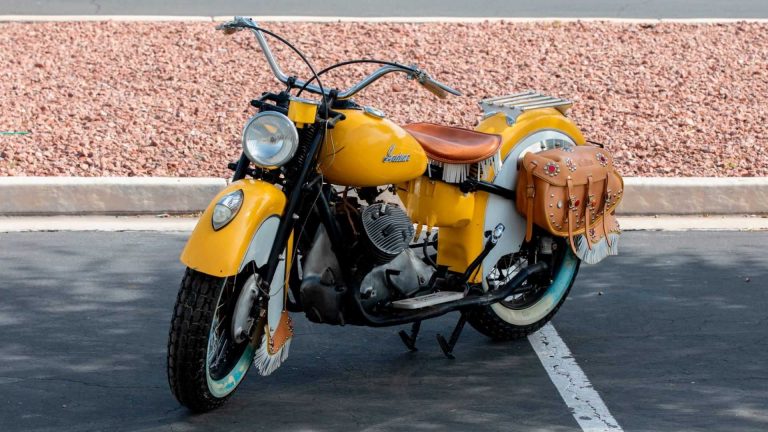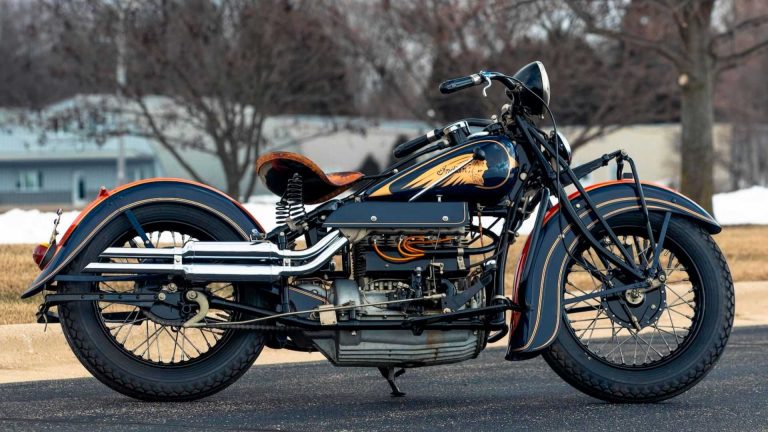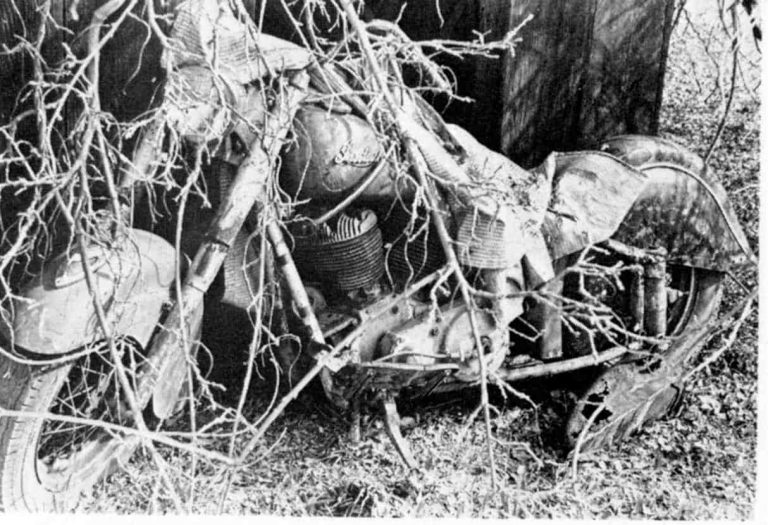The FORGED custom series returns. Three world-renowned builders will be chopping and fabricating on and around the all-new #IndianScout platform, with each build rooted in a historical figure, machine, or era of inspiration taken from Scout’s storied 100+ year history. Hosting throughout this year’s series, and leading the first build, is the West Coast performance protege Roland Sands. The Roland Sands Design team with lead fabricator Aaron Boss have been inspired by Ed “Iron Man” Kretz, winner of the first-ever Daytona 200, to create a high-performance #SportScout racer.
mrindian
“Crafting History: Ronna Norén Transforms the Indian Scout in Forged Series Episode 3”
Indian Motorcycle is extending its acclaimed Forged video series to Europe, featuring Ronna Norén from Unique Custom Cycles in Sweden in its third episode. Norén joins a trio of distinguished builders tasked with crafting bespoke bikes based on the new Indian Scout platform.
Stenegärd first encountered Norén in 1987, captivated by his groundbreaking builds showcased on motorcycle magazine covers, forever altering the landscape of custom motorcycles.
Renowned for his artisan approach, Norén’s creations typically begin with an engine as the centerpiece, around which each bike takes shape.
The inspiration for Norén’s latest project traces back to Stan Dishong, a visionary custom bike builder from the 1950s who foresaw the rise of choppers. Dishong’s legacy includes establishing Stan’s Cycle shop, pioneering parts manufacturing, and even influencing the development of drag bike tires.
Focusing on Dishong’s 1937 Indian Scout, Norén meticulously reworked the steel tube frame, elevating the front end and embodying a 1960s New York chopper aesthetic. The redesign includes extended forks, paired with a 21-inch front wheel and an 18-inch rear wheel. Norén also innovatively restructured the fuel tank, segmenting it into four parts, relocating the fuel pump, and seamlessly integrating it into the modified frame and air filter setup.
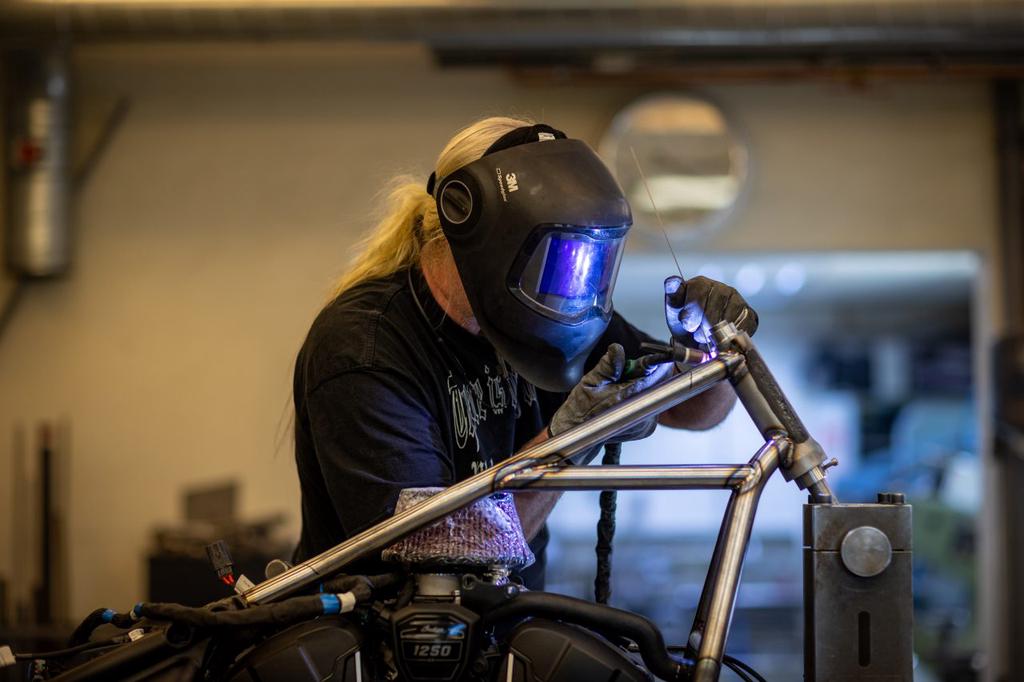
Presented by fellow builder Roland Sands, the Forged series underscores the integral role of customizers within Indian Motorcycle’s design and engineering ethos during the development of the new Indian Scout. Featuring a new steel tube frame and easily interchangeable metal bodywork, the Indian Scout provides a versatile canvas for creative expression.
The concluding episodes of the Forged video series will unveil the finalized builds, each drawing inspiration from historical figures, machines, or eras spanning the Scout’s illustrious century-long history. Subscribe to Indian Motorcycle’s YouTube channel to watch the latest episodes as they premiere
The Story of Big Red
By BOB STARK:
Bob Stark started riding US motorbikes and Cushman scooters at the age of 10. This was in 1944. His son Gary has the edge on him since he got his first Indian at age 4 (a 50cc Mini-Mini).The following story of “BIG RED” is how BOB obtained his second INDIAN. It would have been his first one, but fate stepped in and…well, just read the story to see what happened.
THE STORY OF BIG RED
I was born in Springfield, Mass. in the Spring of 1948. I was delivered to BOB STARK’S father, CHARLES STARK who was the Akron Ohio Indian dealer, for my initial sale. He sold me to a nice Young gentleman who was my companion for only a few short weeks. We covered only 1,760 miles together, when Uncle Sam stepped in and drafted him into the Army for a two year duration. I patiently awaited his return for those two long years while residing in his mother’s garage. Suddenly there was an unexpected turn of events. A letter arrived from him dating that he had signed up for another enlistment and would be gone for another four years. He was worried about my well being and figured another four years of setting alone would not be good for me. He told his mother to dispose of me in the method she determined beat. She decided she needed a new car! so she traded me in at the Dodge dealer on East Market Street in Akron. This gave me a terrible feeling of being unwanted.
I was now alone sitting on a used car lot and not liking it much. On my fourth day there, a young high school kid rode in on his Cushman Motorscooter. We immediately had a feeling for each other and I hoped that he might become my new companion. I heard him talking to the salesman end learned that he was BOB STARK the son of the dealer who initially sold me. My sale price was $450.00, but BOB did not have this much and the salesmen did not wish his scooter on trade. BOB told him he would return soon. BOB talked to his father who said he could buy me if he saved up his own money, but could borrow none from him.
During the next four weeks BOB visited me nearly every day. We had developed a good feeling for each other by then. The salesman was getting tired of being bothered by BOB, until he was notified that BOB was saving money for me and was up to $425.00. I was really looking forward to the final $25.00. Then another disappointment entered my life. The next day an elderly (by comparison then) gentleman, about 32 years old, walked in and laid down the $450.00 required for my purchase. He filled my tank with gas and rode me home.
The next year was again quite lonely. My new owner and I went for only two rides, and he never even had to add any more gas to my tanks. I heard him talking to his brother one day from my obscure location in the back of his garage. He had called The Akron Beacon Journal and listed me for sale – this time for $325.00. The next day the garage door opened and I couldn’t believe my eyes. There stood that same kid again. BOB came running to me in the same state of disbelief. He looked at my odometer and asked my owner if I was sick since he had ridden me only 65 miles in slightly over a year. It seems that my owner had ridden the 500cc Model 741 Scout during the war, and the power of my larger engine had frightened him. I knew BOB figured he had just found a long lost friend. You never saw $325.00 change hands so fast, and my dream of becoming a companion to the kid on the scooter finally happened.

Bob confided in me that he had looked for me so hard, and wanted me so bad, that he never intended to sell me. This incident happened Forty four years ago and we have been life long companions since then. When BOB obtained me I had 1,825 miles on my odometer and I now show 231,000 plus miles. I have never been restored, but have had whatever care has been necessary to keep me healthy. We still attend all of the large western meets together, and have had a lot of fun and all types of adventures. We have aged together but I believe that BOB shows the wear and tear a bit more than I.
Indians Forever – A Visit with Bob Stark
Here’s “Bullet Bob” Stark urging the test Indian “80” past the Chrondeks at a terminal velocity of 81.08mph, 1609 ET.
While the figures might not be impressive alongside times turned in by more modern “Superbikes,” comparing the FFLH times (obtained at the same racetrack last November) with the Chief’s tends to bear out the “Indians Forever” view.
by George Hays
“Hey, I want to get into the rare bike bag,” my buddy announced. “Think I’ll buy an Indian Chief.”
“Oh God, no!” I said, my mind darting back to the early ’50’s when you either rode a Harley, an Indian, or an English bike. Riders were fiercely loyal to their favorite brand of horsepower and harbored an ill-concealed hatred for the other brands. At that time, I rode English bikes, and had no love for American iron, particularly Indians. In those days Indian was becoming an underdog. Show up at a meeting riding an Indian and you were almost laughed out of the club. There was tremendous rivalry between Harley and Indian. Guys may have been the best of friends, until one tried to stay out in front of the pack on an Indian. Then the competition got vicious. Any Harley rider who was beaten by an Indian was really humiliated.
“Well, what’s wrong with a Chief,” my buddy said, interrupting my reverie.
“Like a guy who owned one said,” I replied, “of all the dogs that are and ever were, an Indian Chief takes the cake.”
“But that’s just a secondhand opinion,” my buddy countered. “Tell me exactly what’s wrong with a Chief.”
“Well, for one thing, they are overpriced. Why, I can remember back in the early ’50’s you could pick up a used Chief in average running condition for $50. And they were hard to unload at that price. Now they want a grand for the damn things. I just can’t see paying $1,000 for a $50 machine.”
“Law of supply and demand. Any rare old bike in good shape will bring a grand these days. You still haven’t told me what’s wrong with a Chief. They can’t be all that bad if so many guys like them enough to keep them rolling. You see two or three beautiful old Chiefs at every big road run.”
“Well, I guess I can’t tell you exactly what’s wrong with a Chief,” I admitted, “and I guess it’s about time I found out.”
In my part of the country the man to see if you want to know anything about Chiefs is Bob Stark. He owns 21 of ’em. What he doesn’t know about the Chief hasn’t been discovered yet. Bob’s dad was an Indian dealer in Akron, Ohio from 1918 to 1952, when he retired. Bob took over and ran the shop until 1961, when he moved to Anaheim, California to work as an engineer for Hughes Aircraft. When he moved west, he didn’t leave his Indians behind. He has a four‑car garage plus a patio and backyard full of Indians and parts at his house, plus more goodies stashed in friends’ garages. He’s bought out the parts supply of several other Indian dealers, accumulated more parts by swapping, and his idea of a good vacation is to go hunting for old Indians and bring them home by the truckload.
Five or ten years ago anyone owning that many old motorcycles would have been considered some kind of nut, but these days rare‑bike collectors are in. He saves a few favored models for his own personal collection, but most of them are for resale. He has a profitable hobby restoring old Chiefs to like‑new condition and selling them at $ 1,000 a copy. He will also sell a few parts if he has a surplus of some particular item, but keeps most of his inventory for his own use. If he can’t fix you up, he can tell you where you can get the parts you need.

When asked what’s so great about a Chief Bob replies, “It’s about the most dependable road bike ever made. For example, in 1955 1 bought a Chief that had over 100,000 miles on it. It was an old New York Police bike. I restored it and put 82,000 miles on it between ’56 and ’68 when I sold it. After the restoration job, the total cash that I had to put out to keep that bike rolling was only $62. This included a ring and valve job at 40,000 miles, a few chains, generator belts, tires, and a paint job and second ring and valve job just before I sold it. When you get that kind of service out of a bike, you can’t help but love it.”
Why are there so many more old Indians running around than old Harleys? At big road runs or a classic bike rally you see lots of old Indians ‑Scouts, Chiefs, and Fours, but you rarely see an old Harley.
“That’s because you can get parts for an old Indian a heck of a lot easier than you can for an old Harley,” Bob says. “Sam Pierce, an Indian dealer in San Gabriel, can still sell you just about any part you want. A friend of mine owns a ’57 Harley. Parts for a ’46 Chief are far easier to get than parts for his ’57 Harley. Being American, all nuts, bolts and fittings are standard hardware. And things like oil seals, bearings and electrical parts have standard industry part‑numbers. The spark plugs, generator, points, condenser, distributor, coil and lightbulbs are standard car parts made by Auto Lite. You can buy them over the counter at just about any auto parts store. And prices are about one‑fourth what they would, cost in a bike shop. That’s a big advantage of owning an Indian. If you own a Harley, you have to buy factory parts from a Harley dealer, and pay through the nose. Nothing else fits. And if you own a foreign bike, you have to get a lot of parts on special order.

“There are a few parts that are getting a little hard to find, so I’m manufacturing them myself. Like battery hold‑down clamps, front and rear fender tips, speedometer cables, and the large aluminum casting that covers the distributor on the ’52 and ’53 Chiefs. And I’m making new front fenders out of fiberglass. Other than these parts, you don’t have any trouble getting parts for a Chief.”
Even though the Chief hasn’t been made for over fifteen years, the parts situation is better for owners of old Indians than old Harleys. When you look around at rallies for old bikes, Harley is conspicuous by its absence. The reason is the Harley factory isn’t interested in supplying parts and information to keep the old bikes running. If a Harley is more than 10 years old, the dealers have dumped the parts and it’s hard to get the Harley establishment to even admit they made the bike.
As one rider said, “I wrote the Harley factory for information on my ’38 74. All I wanted was an owner’s manual or something with a little tune‑up information. The factory wrote that there’s nothing available on old bikes, to forget it and buy a new one. So I wrote back and told them that when they start building a motorcycle, I would.”

In 1948 a new Chief sold for $875. A ’53 model, the last ones made, sold, new for $1,275. The market value of a Chief today is $700 for one in good running condition. Basket cases go from $200 to $325. A completely restored Chief is worth between $1,000 and $2,000, depending on the model, condition, and accessories. The 80 cubic‑inch jobs built from 1950 through 1953 are the most sought‑after. Up until 1950, all Chiefs had 74 cubic‑inch engines.
The first Chief rolled off the line at the Indian plant in Springfield, Mass. in 1920. The Chief progressed through various stages of evolution until 1949, when the Indian Company discontinued the Chief in favor of the English‑style Arrow and Scout. These models didn’t sell well, so the Chief was produced again in 1950. The last Chiefs were made in 1953, with the exception of a few made in 1955 on special order for a police department.
The most popular model today is the Bonneville, the high‑performance version built from 1950 to 1953. The Bonneville featured high‑compression pistons giving a compression ratio of 6 to 1, magneto ignition, ported valve seats, polished intake manifold, hot cams, and extra balancing and polishing in the lower end. When new, the Bonneville cost $40 more than the standard model, but few buyers would go the difference.

Bob Stark keeps several Chiefs in his collection in top running condition and is always willing to take a friend for a demonstration ride. Climbing on the dual seat behind Bob, you are impressed by the brute low‑speed torque of the old bike as it takes off. You are thankful for the rail around the back of the seat that keeps you from sliding off as he opens the throttle and the old beast lunges forward. The huge 61‑inch wheelbase positions both rider and passenger well forward of the rear axle, providing a feeling of stability and good handling unknown in most modern bikes. When the old machine hits 2nd and 3rd gear your head tends to snap back as the huge engine comes on strong. Approaching a red signal Bob hits the brakes, and you are impressed by how quickly the bike comes to a halt. The brakes are quite adequate, equal to the brakes on most modern machines. Plodding through traffic the Chief lugs along smoothly at 20mph in high gear. Due to the wide torque range, shifting is almost unnecessary, and the three‑speed transmission is all that’s needed.
Out on the freeway, Bob runs it up to 70mph. The big engine chuffs away slowly, giving the feeling that it will run forever without stress or wear. There’s some vibration, but the Chief runs smoother than most bikes of its era.
Gas mileage for a Chief is about 35mpg. Depending on tune and condition, a Chief will get from 32mpg to 48.
Top speed for the Bonneville is 112mph. A standard model will do 100. A hot Chief has turned 118 in a quarter‑mile. A standard Chief will do the quarter in the 80’s. Most owners of rare bikes are content to sit around and brag about the performance of their old machines. They have too much time and money invested in the restoration of their engines to risk blowing them up to prove they will go.
But not Bob Stark. He’s quite willing to show you what a Chief will do, so we headed for the local drag strip. As soon as arrived we knew we had a winner, at least as far as attracting a lot of attention is concerned. As Bob started removing his windshield, a small crowd of interested spectators gathered around the old bike. Bob rolled the old Chief up to the line, the light turned green, and he blasted off. The crowd in the stands waited eagerly for his time to be announced, more interested in what the old Chief could do in a quarter‑mile than in the times turned by the half‑dozen run of the mill superbikes on hand.

The best Bob could coax out of the old bike was 81.08mph, with an elapsed time of 16.09. Nothing exciting when compared with today’s superbikes, but not bad for a stock, fully equipped road bike ridden by a rider weighing close to 200 pounds.
So what’s wrong with a Chief? Well, no bike is perfect, and if you check a a Chief carefully, you can find a few things that could be improved. Like the transmission. Modern transmissions have gears that are in constant mesh. Shifting is done by sliding dogs. But the Chief has sliding gears and shifting tends to wear the gears out. Particularly since the Indian clutch always seems to drag a bit, and it’s difficult to shift without clashing. Gear shifting was improved in ’53, the last year Chiefs were made, by adding a brake mechanism to the clutch that brought the gears to a halt so they could be shifted without clashing. But the transmission is crude by today’s standards.
A hot Chief could tear the ears off a stock Harley, but in the Indian era some didn’t like the Chief because it wasn’t quite as fast as a stock Harley 74. And it looked a lot heavier. With massive fenders, chainguard and distributor cowling, it looked heavier than it was. Actually, it weighed 590 pounds, about 40 pounds lighter, year for year, than the Harley. The Harley 74’s made today are several hundred pounds heavier than the Chief.
By today’s standards the side‑valve engine with compression ratio of only 6 to I is antiquated. The control arrangement is weird‑hand shift, and foot‑operated clutch.
But in other ways the Chief was ahead of its time. The bike still doesn’t look antiquated today, and people who don’t know their motorcycles mistake a restored Chief for a new machine. When Bob enters a Chief in a bike‑judging contest, he puts it in with the modified stock 74’s rather than in the antique class, and he usually wins. He took the trophy three years in a row at the Indio Tour. Altogether, his Chiefs have won 30 trophies in bike shows.
When you come right down to facts, there’s really not much wrong with a Chief. You either like them or you don’t. Like Bob Stark says, “I enjoy riding something different. I get a lot of fun out of taking an old Chief out and running right along with the new bikes and putting down those who badmouth Indians.”
It’s no superbike, but if you want an old bike that attracts a lot of attention, a bike that will cruise at 80, that is dependable and reasonably easy to get parts for, then maybe an Indian Chief is your bag.
While an engineer at Hughes Aircraft in Los Angeles, Bob Stark was an avid hobbyist in Indian Motorcycles. This article shows his passion for the Indian Motorcycle before he decided to start his hobby as a full time business. Reprinted with permission from Cycle Illustrated November 1970
The 1941 Indian 841 Was A U.S. Army Commission For Desert Missions
A unique prototype.
You wouldn’t know it from its flamboyant appearance, a screaming yellow zonker bejeweled with leather and fringe. Like most superheroes, though, this Indian has a hidden past and a secret identity. Indian did not create this bike for civilian use, as it eventually entered. It created this bike to punch Nazis like Captain America.
Although the United States had not yet entered World War II in early 1941, it was already supplying equipment to the Allies. The undisputed king of the north African desert was the BMW R71. Its boxer-twin engine stayed cool in the heat thanks to its exposed heads, and its shaft drive never got gunked up with sand. The US Army challenged Harley-Davidson and Indian to come up with motorcycles to combat this foe. Harley pretty much copied the R71 with the XA, complete with its boxer engine and shaft drive. It’s the easy way out, but it was the fastest way to provide a motorcycle that met the Army’s requirements, and we can’t fault them for that.
Gallery: 1941 Indian 841
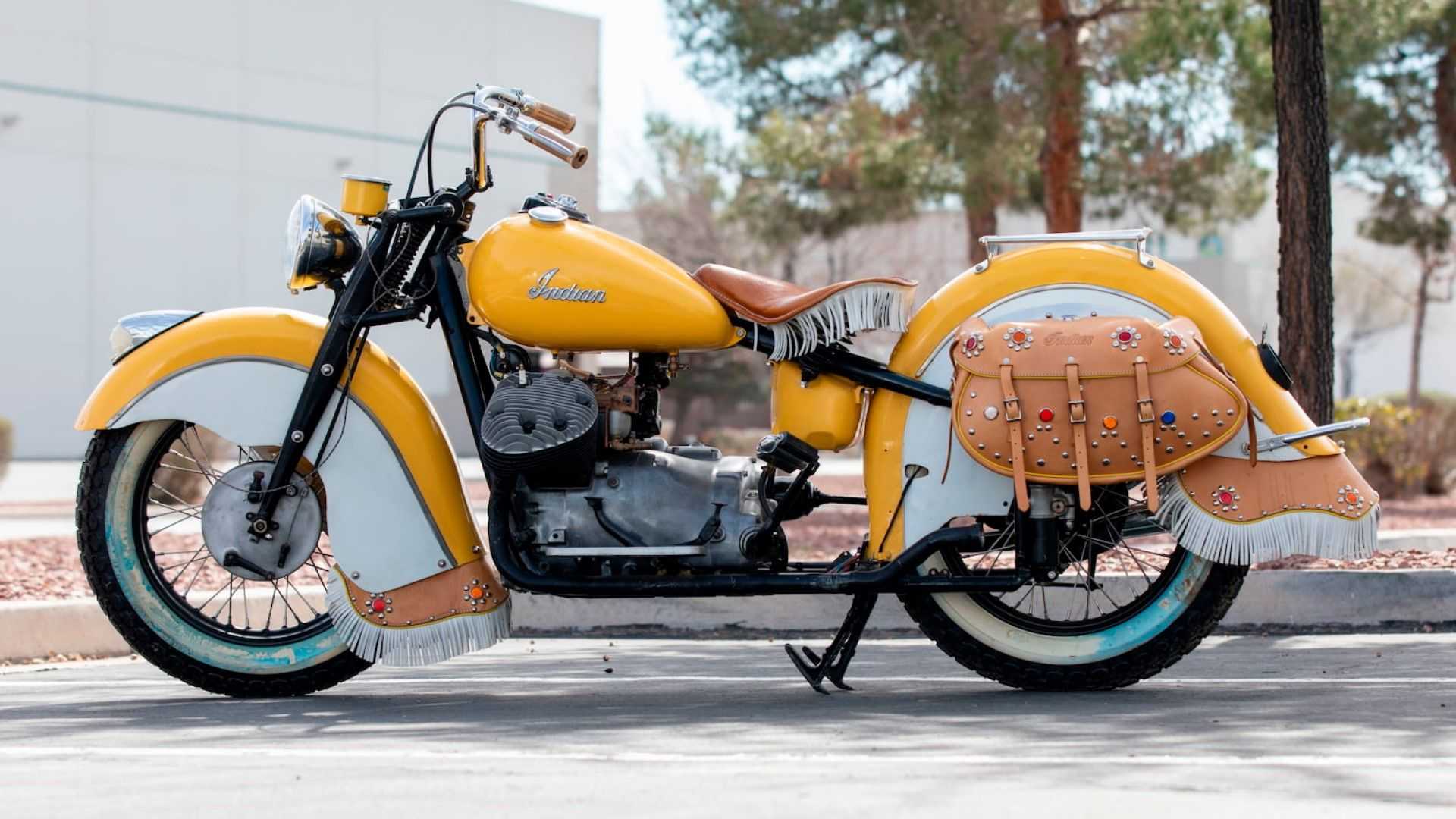
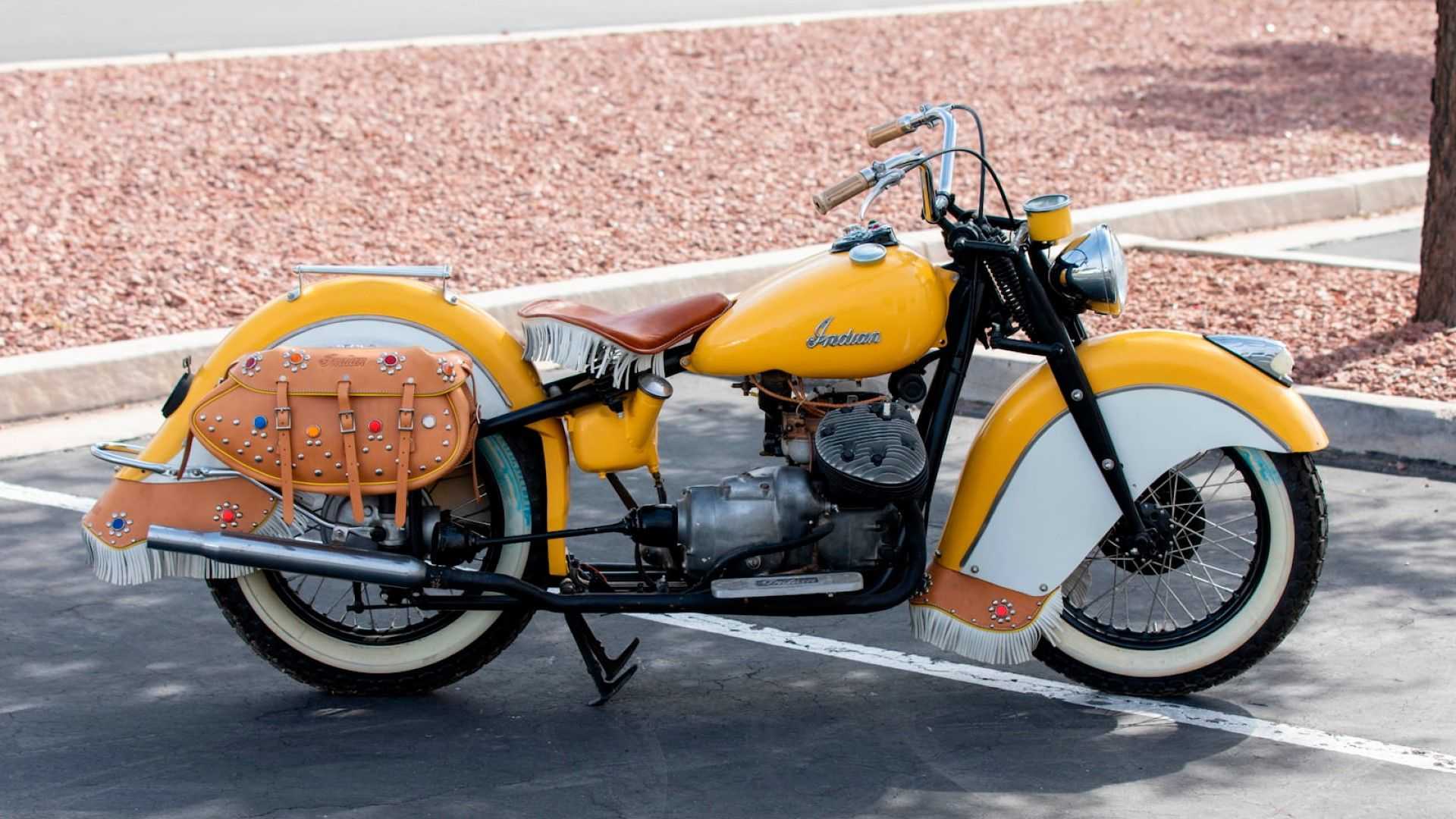
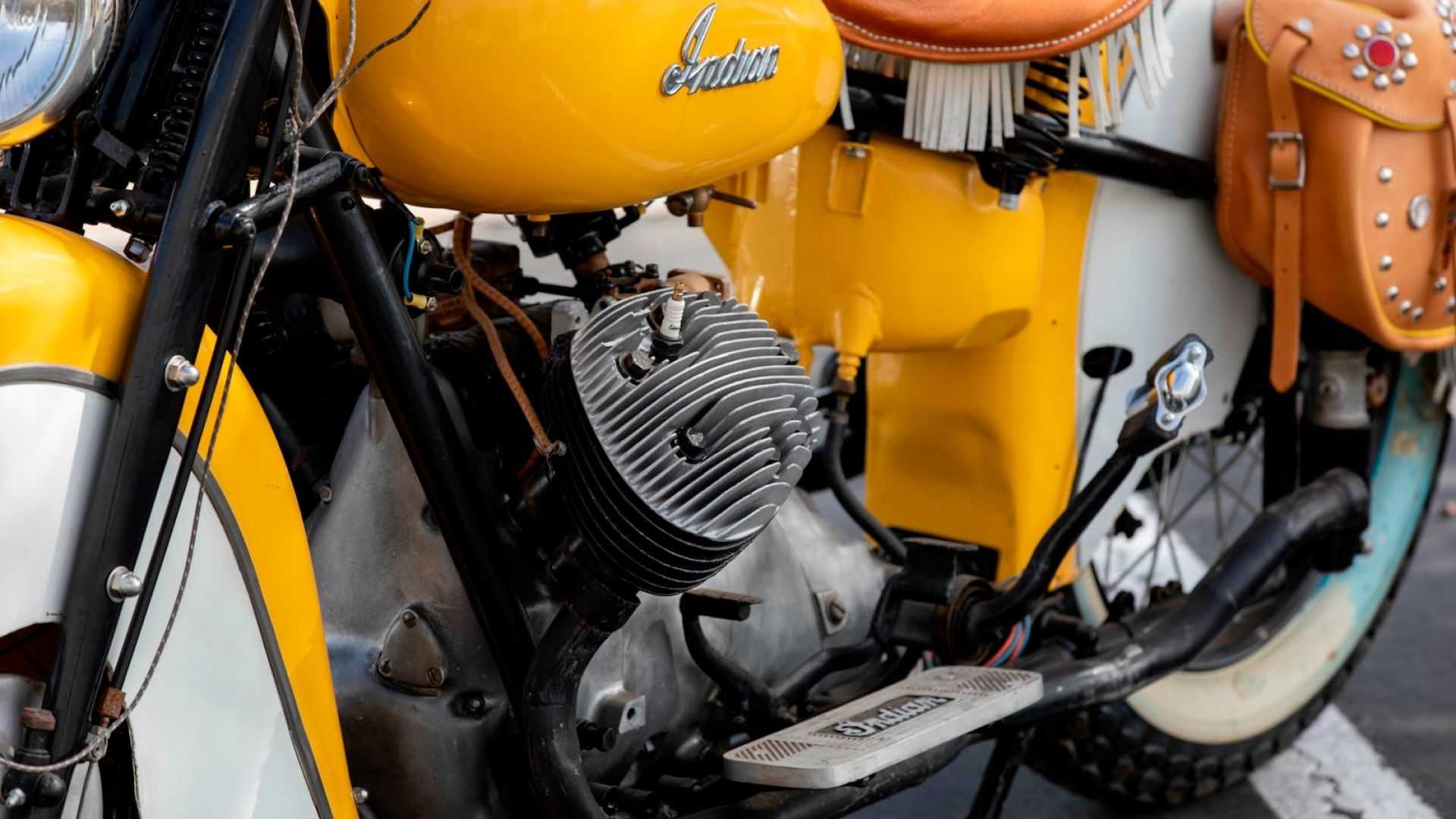
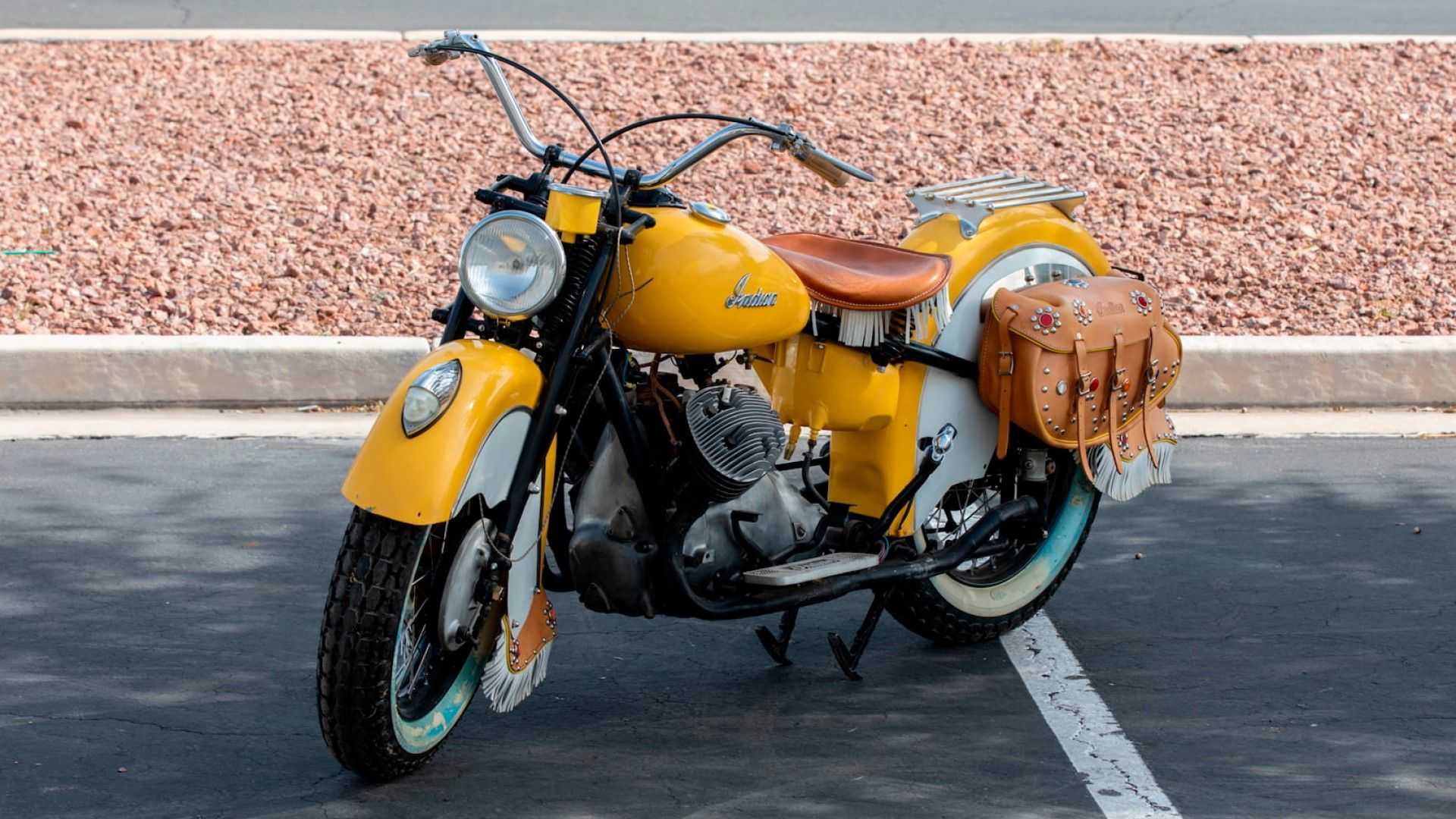
Indian, however, took a more unique approach. They designed a new 90-degree V-twin engine using the same heads as the Scout, though with compression reduced to 5.1-to-1 so it could run on low-quality gas. This engine sat not longitudinally inside the frame, but in a transverse configuration, like a Moto Guzzi or Honda CX500. This allowed the cylinders to stick out in the open and gain the same cooling benefit the BMW had. It also made the shaft drive easy to implement since the crankshaft was already spinning in the proper orientation.
The result was the rather blandly named 841. The Army commissioned 1,000 of these and tested them extensively against the Harley-Davidson XA. Ultimately, the Army did not adopt either of them, and Indian sold its remaining 841s to the general public. Owners usually repainted them and adorned them with accessories like other Indians of the time. That’s how this former Army brat got its distinctive appearance. This particular one goes up for auction at Mecum at the end of April. While it has undergone an extensive restoration, it’s being sold “not for highway or public road use.” It’s still a neat piece of history with a secret identity.
Source: The 1941 Indian 841 Was A U.S. Army Commission For Desert Missions
Yes, Indian Made An Inline-Four Motorcycle Engine
They’re not just for sportbikes.
We usually think of Indian as one of the American Big Two alongside Harley-Davidson. Both have offered traditional big American V-twin cruisers since back before the Earth cooled. The biggest departure we’ve seen Indian make from this is the FTR 1200, which still has a V-twin. What if Indian had gone what we consider the Japanese route, with an inline-four engine instead? The truth is, they already have.
After selling the company to Excelsior, William Henderson (yes, that one) struck out on his own and founded the Ace Motor Corporation. He designed a new four-cylinder engine, one that couldn’t be too similar to the one he had sold, along with the company and patents, to Excelsior. The result was one of the fastest bikes available, as proven by Erwin “Cannonball” Baker setting a cross-country speed record on one in 1922. Sadly, Henderson died later that year. The company floundered with his loss and eventually sold out to Indian in 1926. The result was the Indian Ace, which was the old bike sold under the Indian name.
Gallery: 1936 Indian Four
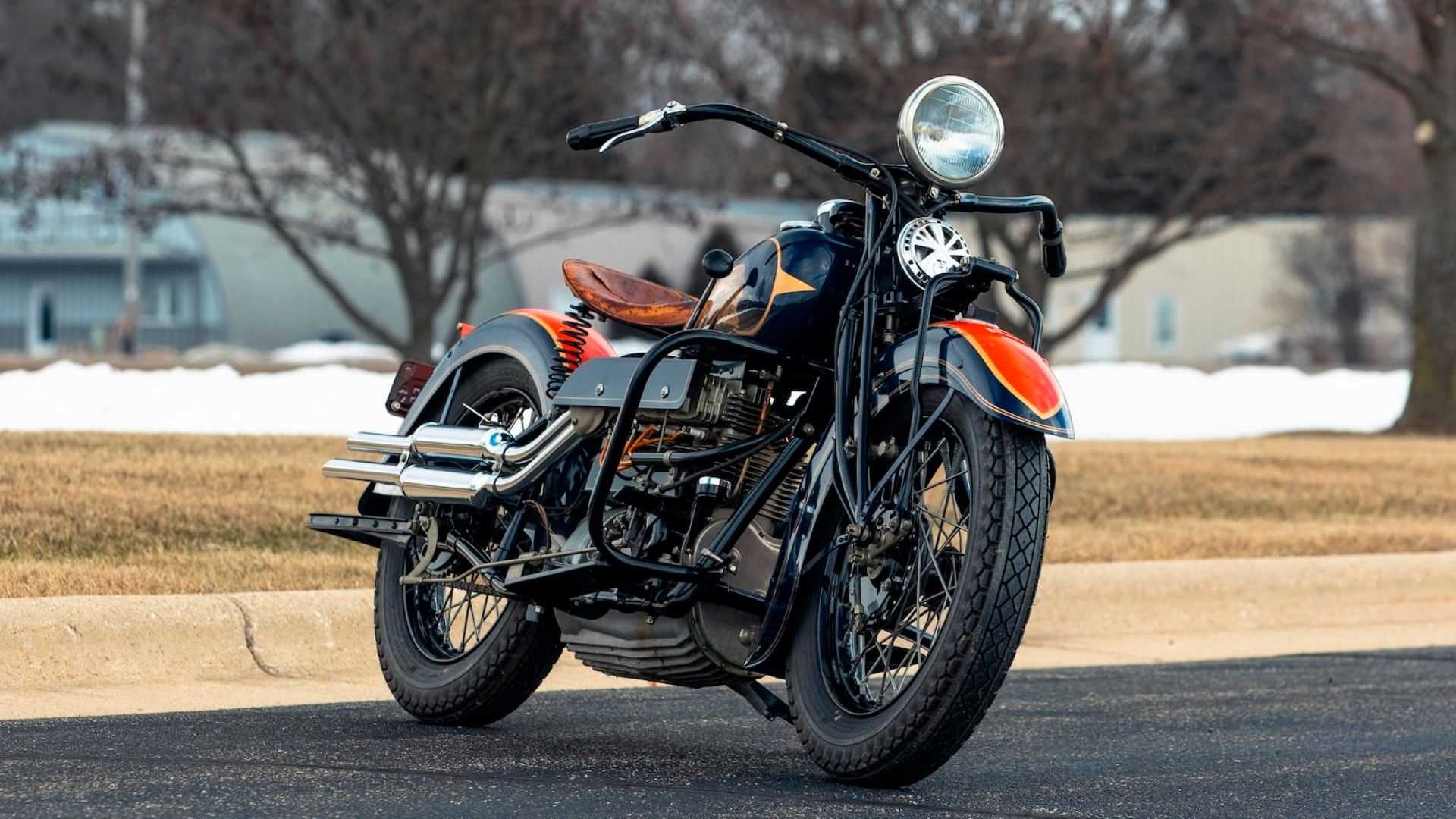
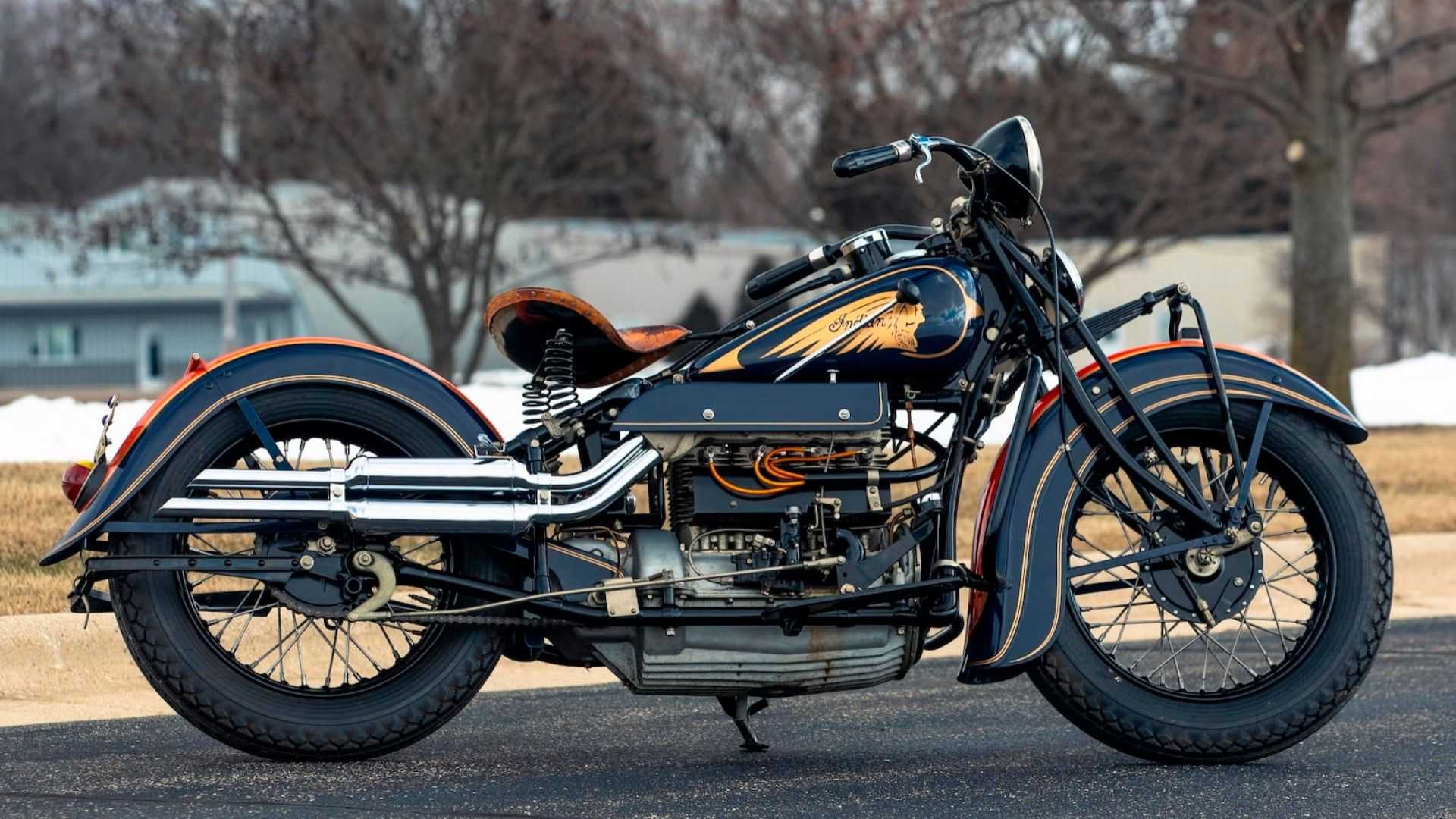
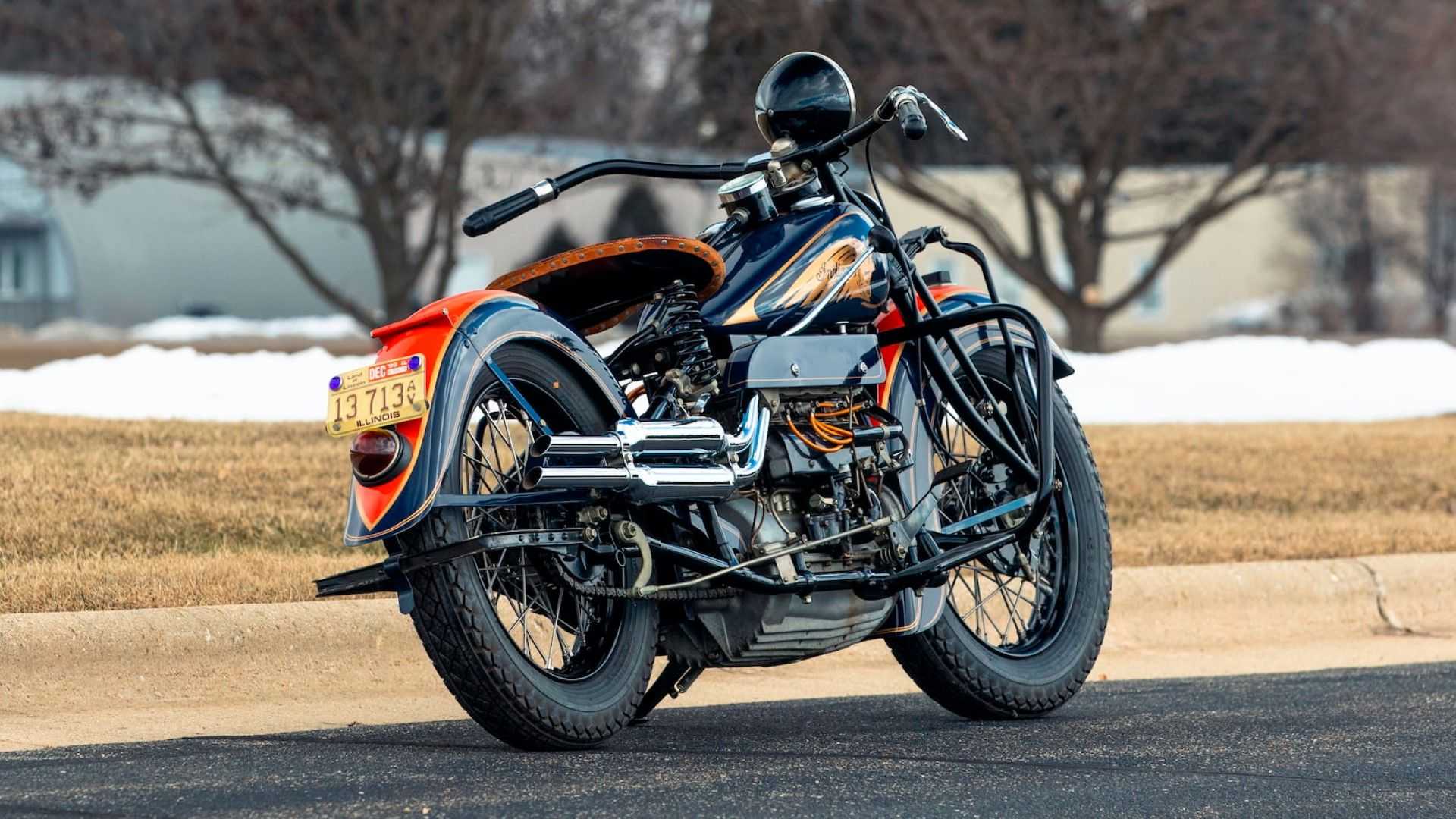
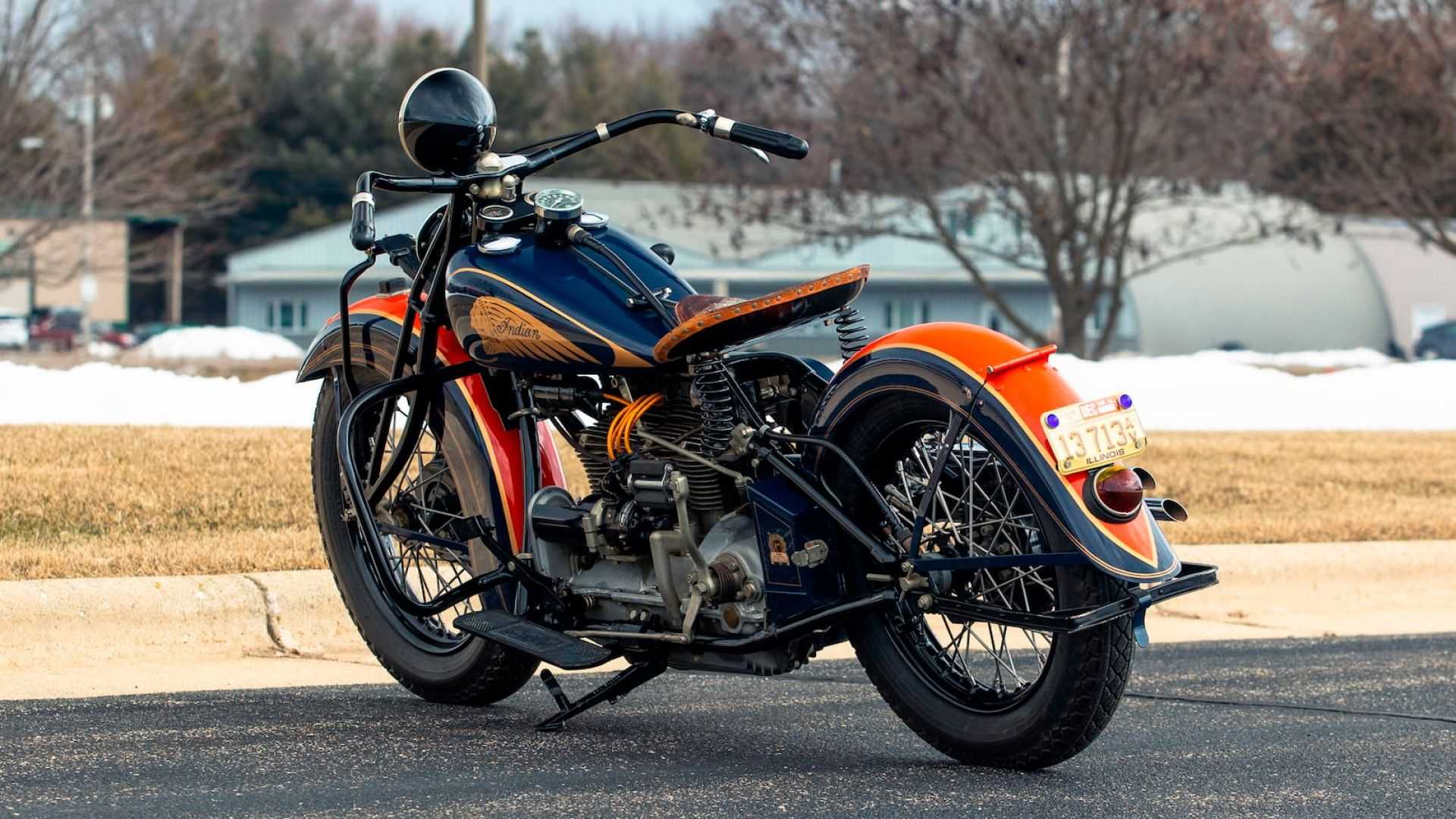
Indian was only just beginning, though. It continued developing the four-cylinder engine with former Henderson designer Arthur Lemon, who knew it best at this point. As the design evolved beyond the original Ace, that name was dropped, and the model became known as the Indian Four. One of the innovations, introduced in this 1936 model, was the “upside-down” engine. This variant pulled air in through the carburetor into the bottom of the head and blew it out the top, the opposite of how most engines work. The high-mounted exhaust isn’t trying to be a scrambler. It’s simply the most efficient routing for the top-exit exhaust.
Unfortunately, this placed the hot exhaust extremely close to the rider’s rather sensitive body parts, making for an uncomfortable ride. This, plus a high-maintenance exhaust valvetrain, made the bike less popular than its predecessors despite a noticeable horsepower increase in the new design. The 1938 model went back to the traditional downdraft design, making models with the “upside-down” engine quite rare. Indian continued to develop the Four until World War II, when they switched to military production. The Four never came back after the war.
This 1936 Indian Four is probably one of the best remaining examples of the upside-down engine model. It was restored by Peter Bollenbach, who was known for the excellence of his classic Indian motorcycle restorations, and looks like it just came off the showroom floor. It will go up for auction at Mecum at the end of April. There is no starting bid currently listed, but expect it to be high.
Source: Yes, Indian Made An Inline-Four Motorcycle Engine
Restoration of the Relics
History of Starklite Cycle
Bob Stark looks up from his sweeping chores and smiles his recognition. “Hi, ” he says. “Just trying to get the place back in shape. You wouldn’t believe the mess we’ve had in here the past couple of days . ” He hands the broom to his wife, Mary Lou, who takes it good-naturedly and begins sweeping where Bob left off. “I just got back from Texas, ” Bob explains. “Picked up a dozen Chiefs down there. ” He shakes his head slowly. “They were in terrible shape — we just managed to get them into rolling condition this morning. But it sure messed the place up. Come on in. there’s a cup of coffee in the pot. “
In a world gone slightly batty in the search for better mousetraps, high-gain low-quality production potentials, and methods of making the modular concept work, it’s kind of nice to find a place of business where the owner drops what he’s doing and offers you a cup of coffee. Bob Stark is that kind of a guy. Reserved, soft-spoken — he’s never too busy to answer a question or look up a part number or a statistic. His role in the story of Indian Today is one of dedication that paid off.
“Let’s see — my first bike was a Whizzer Motorbike, ” Bob recalls. “That was back in 1946. My father was a motorcycle dealer in Akron, Ohio then. He handled Indian, Ariel, Zundapp and Triumph. Even though he’d been an Indian dealer since 1918, for some reason he didn’t want me to have a motorcycle of my own. the Whizzer was okay, or a Cushman scooter would have been Al right. But no ‘real’ motorcycles.
“So I had to keep my first Indian a secret. ” Bob smiles. “I guess it was wrong, but I just had to have a motorcycle.

I bought this dilapidated old converted Army Model Scout in 1950 for next to nothing It was a mobile disaster area. Rust and broken pieces and the fenders falling off. But I was proud of it — in a secret sort of way. I owned it for almost six months before my dad found out about it He’d seen me riding around on it once too often and figured I belonged to it I had to confess.
“It was in such terrible shape that even though he gave in to the idea of my owning a cycle, he didn’t want me on the Scout. So he offered me a straight-across trade for any bike in his shop. I traded even for a 1950 triumph 650 cc Thunderbird ! But there was something about the old Indian that wouldn’t let go, and within two months I bought a ’46 Chief and a’48 Chief. I’ve been an Indian fan ever since.
“My father died in 1954, and then in 1957 I reopened the shop in Akron at the same location. I handled– let’s see — it was Royal Enfield, Parilla and Matchless. I even raced the little Parillas for a while. But I sold the shop to my brother in 1960 and moved to Florida for my health “

While we are talking, four young men come into the shop and browse around for a few minutes, impressing each other with their Indian lore. One of them finally starts looking around like he wants to do business, and Bob excuses himself and goes over The young customer is looking for an Indian he can “make into a chopper”. He asks some questions and eventually gets around to the big one: How much is something that runs? Bob mentions a figure which is received with obvious disappointment. there are a few more half-hearted questions, the quartet mills around for a few more minutes and then leave. Bob comes back over and sits down.
“That happens all the time, ” he explains. “People still think that they can find a 75-dollar Indian that runs. ” He shakes his head. “Not any more The market is going up like a rocket– increasing every year. Bikes I sold four or five years ago can be sold right now for over twice what I asked for them. the value just goes up every year. Most guys that are buying Indians these days consider them as investments. They buy knowing that they won’t lose money. That’s why you find more and more professional level people in the motorcycle collecting field. Doctors, Lawyers, Businessmen, conservative people who want original restoration, not modifications or stray parts taken from other motorcycles. It’s a thriving business, but there’s a problem — the demand has created a lot of small businesses like this one, but in many cases the work isn’t up to par, they’re just slapping parts together.

Bob prides himself on his work. “If I wouldn’t want to own a bike I’ve restored, ” he states, “then it isn’t good enough for the customer. Sometimes it takes a little longer; sometimes it costs a little more — but when it’s done, it’s done right. “
How long has he been building Indians? “Well, not counting the machines I build for my own personal use, I’ve been restoring them and selling them since I moved to California in 1962. The shop itself–” he waves his hand in an inclusive arc, “– is only eight months old. It just got to where the demand was such that we felt we had to answer it. So far, so good.
“Problems ? ” Bob frowns, then nods his head . “I guess the biggest problem is the nature of the business itself. The old Indians are getting harder and harder to find. Every once in a while you can find a windfall — and there are still some setting around in barns here and there. But sometimes it’s pretty sad. Like these old Chiefs I got down in Texas. They were in terrible condition. What it amounts to is that I went down and bought twelve rusty hulks! They’re restorable, but it won’t be easy.
What usually happens is that someone will have a few old bikes sitting around. He’s probably aware that there is a potential value on the collector’s market. So he just hangs on to them, figuring that the longer he keeps them, the higher the price will go. But what he doesn’t realize is that they have to be kept up in order to keep them from deteriorating entirely. A machine — any machine — has to be run. You can’t just neglect them. Just sitting there under a tree someplace, they rust out and become worth- less. It’s a shame.

“And there’s the parts problem of course. As far as engine components are concerned, that’s not much of a real problem. ” Bob smiles. “Actually there’s a rumor going around that an Indian owner can get parts easier than a Harley owner I know of several people who are currently making some parts too. I think there’s probably three to four times as many parts available today than there was — say — five or ten years ago. The things that are the hardest to find are the sheet metal parts and trim, things like that. That’s why we’re trying to get our Indian group together. “
Bob reaches into the shelves behind him and picks up a small polished metal piece. “This is a fender tip for the Chief, ” he explains. “It’s identical to the original item, but we made it ourselves. The only drawback to making parts is that the molds cost so much to make. What we’re doing is organizing under the name Indian Motorcycle Club of America. Most of the membership dues will go into the manufacture of molds to make hard-to-get or obsolete parts. Then we can sell the parts back to members at a pretty fair discount. the more members, the less the cost per item will be. We’re already in production on battery hold-downs, distributor covers, exhaust mufflers for the four cylinder models; gear-shift knobs and foot board extensions . It’ s one way to beat the scalpers — they charge you a small fortune if they know you’re having a tough time finding a part.
“Also we’re putting together a complete file on everything pertaining to Indian–history, specifications, everything. That way we can setup a question and answer service, so that if a member wants some information on any given model – for instance, a list of Accessories or the original paint options — we can simply Xerox a copy of the particular information he wants and send it back to him . “
The idea of being able to tell anyone who’s interested anything they want to know about Indian appeals to Bob Stark. At present, he’s a very happy person — an industrious, polite kind of guy who has found a niche in the mad mad world to do what he enjoys the most. But Bob’s part in the story of Indian Today doesn’t end with his new and growing business. And it would be unfair to categorize him as being representative of the swelling ranks of Indian restorers without letting you see a few of the samples in his personal collection.

Well known to Southern California enthusiasts is Bob ‘s beautiful Rainbow Chief, a 1948 seventy-four which features a 1950 front end and a unique hand-clutch/foot-shift arrangement which took him two years and ten failures to perfect A striking maroon And sunburst machine) a judge ‘s delight.!

All of the bikes in Bob Stark’s collection are built to be ridden. Nothing is strictly for show. The Rainbow is ridden annually to Indio and other California motorcycle shows, is displayed and ridden home again. Matter of fact, after winning the number one trophy in his class, Bob rode the big twin to second place finish in the Indio field meet competition last Year!

Restoration of the Relics
History of Starklite Cycle
Restoration of the Relics

Bob Stark looks up from his sweeping chores and smiles his recognition. “Hi, ” he says. “Just trying to get the place back in shape. You wouldn’t believe the mess we’ve had in here the past couple of days . ” He hands the broom to his wife, Mary Lou, who takes it good-naturedly and begins sweeping where Bob left off. “I just got back from Texas, ” Bob explains. “Picked up a dozen Chiefs down there. ” He shakes his head slowly. “They were in terrible shape — we just managed to get them into rolling condition this morning. But it sure messed the place up. Come on in. there’s a cup of coffee in the pot. “
In a world gone slightly batty in the search for better mousetraps, high-gain low-quality production potentials, and methods of making the modular concept work, it’s kind of nice to find a place of business where the owner drops what he’s doing and offers you a cup of coffee. Bob Stark is that kind of a guy. Reserved, soft-spoken — he’s never too busy to answer a question or look up a part number or a statistic. His role in the story of Indian Today is one of dedication that paid off.
“Let’s see — my first bike was a Whizzer Motorbike, ” Bob recalls. “That was back in 1946. My father was a motorcycle dealer in Akron, Ohio then. He handled Indian, Ariel, Zundapp and Triumph. Even though he’d been an Indian dealer since 1918, for some reason he didn’t want me to have a motorcycle of my own. the Whizzer was okay, or a Cushman scooter would have been Al right. But no ‘real’ motorcycles.
“So I had to keep my first Indian a secret. ” Bob smiles. “I guess it was wrong, but I just had to have a motorcycle.

I bought this dilapidated old converted Army Model Scout in 1950 for next to nothing It was a mobile disaster area. Rust and broken pieces and the fenders falling off. But I was proud of it — in a secret sort of way. I owned it for almost six months before my dad found out about it He’d seen me riding around on it once too often and figured I belonged to it I had to confess.
“It was in such terrible shape that even though he gave in to the idea of my owning a cycle, he didn’t want me on the Scout. So he offered me a straight-across trade for any bike in his shop. I traded even for a 1950 triumph 650 cc Thunderbird ! But there was something about the old Indian that wouldn’t let go, and within two months I bought a ’46 Chief and a’48 Chief. I’ve been an Indian fan ever since.
“My father died in 1954, and then in 1957 I reopened the shop in Akron at the same location. I handled– let’s see — it was Royal Enfield, Parilla and Matchless. I even raced the little Parillas for a while. But I sold the shop to my brother in 1960 and moved to Florida for my health “

While we are talking, four young men come into the shop and browse around for a few minutes, impressing each other with their Indian lore. One of them finally starts looking around like he wants to do business, and Bob excuses himself and goes over The young customer is looking for an Indian he can “make into a chopper”. He asks some questions and eventually gets around to the big one: How much is something that runs? Bob mentions a figure which is received with obvious disappointment. there are a few more half-hearted questions, the quartet mills around for a few more minutes and then leave. Bob comes back over and sits down.
“That happens all the time, ” he explains. “People still think that they can find a 75-dollar Indian that runs. ” He shakes his head. “Not any more The market is going up like a rocket– increasing every year. Bikes I sold four or five years ago can be sold right now for over twice what I asked for them. the value just goes up every year. Most guys that are buying Indians these days consider them as investments. They buy knowing that they won’t lose money. That’s why you find more and more professional level people in the motorcycle collecting field. Doctors, Lawyers, Businessmen, conservative people who want original restoration, not modifications or stray parts taken from other motorcycles. It’s a thriving business, but there’s a problem — the demand has created a lot of small businesses like this one, but in many cases the work isn’t up to par, they’re just slapping parts together.

Bob prides himself on his work. “If I wouldn’t want to own a bike I’ve restored, ” he states, “then it isn’t good enough for the customer. Sometimes it takes a little longer; sometimes it costs a little more — but when it’s done, it’s done right. “
How long has he been building Indians? “Well, not counting the machines I build for my own personal use, I’ve been restoring them and selling them since I moved to California in 1962. The shop itself–” he waves his hand in an inclusive arc, “– is only eight months old. It just got to where the demand was such that we felt we had to answer it. So far, so good.
“Problems ? ” Bob frowns, then nods his head . “I guess the biggest problem is the nature of the business itself. The old Indians are getting harder and harder to find. Every once in a while you can find a windfall — and there are still some setting around in barns here and there. But sometimes it’s pretty sad. Like these old Chiefs I got down in Texas. They were in terrible condition. What it amounts to is that I went down and bought twelve rusty hulks! They’re restorable, but it won’t be easy.
What usually happens is that someone will have a few old bikes sitting around. He’s probably aware that there is a potential value on the collector’s market. So he just hangs on to them, figuring that the longer he keeps them, the higher the price will go. But what he doesn’t realize is that they have to be kept up in order to keep them from deteriorating entirely. A machine — any machine — has to be run. You can’t just neglect them. Just sitting there under a tree someplace, they rust out and become worth- less. It’s a shame.

“And there’s the parts problem of course. As far as engine components are concerned, that’s not much of a real problem. ” Bob smiles. “Actually there’s a rumor going around that an Indian owner can get parts easier than a Harley owner I know of several people who are currently making some parts too. I think there’s probably three to four times as many parts available today than there was — say — five or ten years ago. The things that are the hardest to find are the sheet metal parts and trim, things like that. That’s why we’re trying to get our Indian group together. “
Bob reaches into the shelves behind him and picks up a small polished metal piece. “This is a fender tip for the Chief, ” he explains. “It’s identical to the original item, but we made it ourselves. The only drawback to making parts is that the molds cost so much to make. What we’re doing is organizing under the name Indian Motorcycle Club of America. Most of the membership dues will go into the manufacture of molds to make hard-to-get or obsolete parts. Then we can sell the parts back to members at a pretty fair discount. the more members, the less the cost per item will be. We’re already in production on battery hold-downs, distributor covers, exhaust mufflers for the four cylinder models; gear-shift knobs and foot board extensions . It’ s one way to beat the scalpers — they charge you a small fortune if they know you’re having a tough time finding a part.
“Also we’re putting together a complete file on everything pertaining to Indian–history, specifications, everything. That way we can setup a question and answer service, so that if a member wants some information on any given model – for instance, a list of Accessories or the original paint options — we can simply Xerox a copy of the particular information he wants and send it back to him . “
The idea of being able to tell anyone who’s interested anything they want to know about Indian appeals to Bob Stark. At present, he’s a very happy person — an industrious, polite kind of guy who has found a niche in the mad mad world to do what he enjoys the most. But Bob’s part in the story of Indian Today doesn’t end with his new and growing business. And it would be unfair to categorize him as being representative of the swelling ranks of Indian restorers without letting you see a few of the samples in his personal collection.

Well known to Southern California enthusiasts is Bob ‘s beautiful Rainbow Chief, a 1948 seventy-four which features a 1950 front end and a unique hand-clutch/foot-shift arrangement which took him two years and ten failures to perfect A striking maroon And sunburst machine) a judge ‘s delight.!

All of the bikes in Bob Stark’s collection are built to be ridden. Nothing is strictly for show. The Rainbow is ridden annually to Indio and other California motorcycle shows, is displayed and ridden home again. Matter of fact, after winning the number one trophy in his class, Bob rode the big twin to second place finish in the Indio field meet competition last Year!



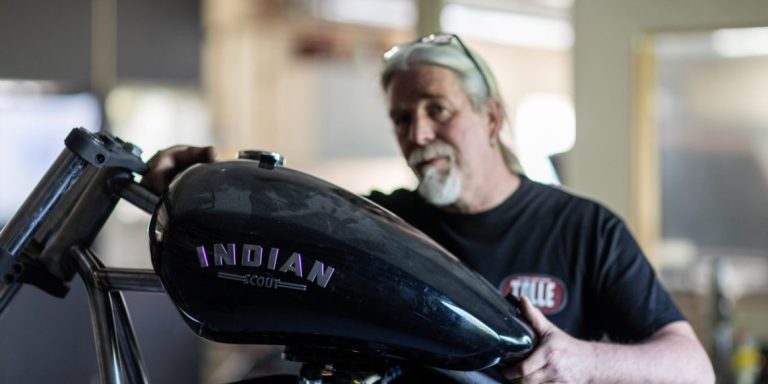
![bigred2[1]](https://stage.indian-motorcycles.com/wp-content/uploads/2021/03/bigred21.jpg)
![bulletbob[1]](https://stage.indian-motorcycles.com/wp-content/uploads/2021/03/bulletbob1-768x497.jpg)
